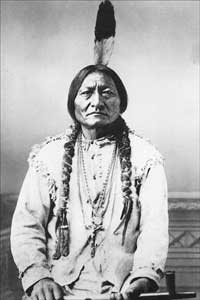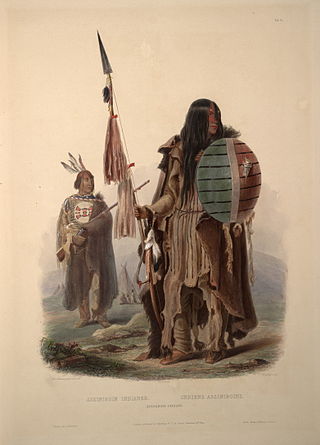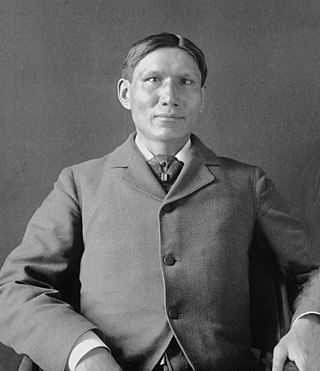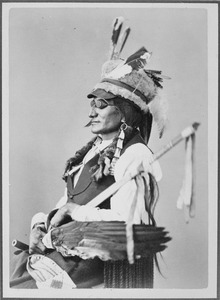
The Crow, whose autonym is Apsáalooke, also spelled Absaroka, are Native Americans living primarily in southern Montana. Today, the Crow people have a federally recognized tribe, the Crow Tribe of Montana, with an Indian reservation, the Crow Indian Reservation, located in the south-central part of the state.

The Lakota are a Native American people. Also known as the Teton Sioux, they are one of the three prominent subcultures of the Sioux people, with the Eastern Dakota (Santee) and Western Dakota (Wičhíyena). Their current lands are in North and South Dakota. They speak Lakȟótiyapi—the Lakota language, the westernmost of three closely related languages that belong to the Siouan language family.

The Sioux or Oceti Sakowin are groups of Native American tribes and First Nations people from the Great Plains of North America. The Sioux have two major linguistic divisions: the Dakota and Lakota peoples. Collectively, they are the Očhéthi Šakówiŋ, or "Seven Council Fires". The term "Sioux", an exonym from a French transcription of the Ojibwe term Nadowessi, can refer to any ethnic group within the Great Sioux Nation or to any of the nation's many language dialects.

Sitting Bull was a Hunkpapa Lakota leader who led his people during years of resistance against United States government policies. Sitting Bull was killed by Indian agency police accompanied by U.S. officers and supported by U.S. troops on the Standing Rock Indian Reservation during an attempt to arrest him at a time when authorities feared that he would join the Ghost Dance movement.

The Blackfoot Confederacy, Niitsitapi, or Siksikaitsitapi, is a historic collective name for linguistically related groups that make up the Blackfoot or Blackfeet people: the Siksika ("Blackfoot"), the Kainai or Blood, and two sections of the Peigan or Piikani – the Northern Piikani (Aapátohsipikáni) and the Southern Piikani. Broader definitions include groups such as the Tsúùtínà (Sarcee) and A'aninin who spoke quite different languages but allied with or joined the Blackfoot Confederacy.

The Assiniboine or Assiniboin people, also known as the Hohe and known by the endonym Nakota, are a First Nations/Native American people originally from the Northern Great Plains of North America.

The Standing Rock Reservation lies across the border between North and South Dakota in the United States, and is inhabited by ethnic "Hunkpapa and Sihasapa bands of Lakota Oyate and the Ihunktuwona and Pabaksa bands of the Dakota Oyate," as well as the Hunkpatina Dakota. The Ihanktonwana Dakota are the Upper Yanktonai, part of the collective of Wiciyena. The sixth-largest Native American reservation in land area in the US, Standing Rock includes all of Sioux County, North Dakota, and all of Corson County, South Dakota, plus slivers of northern Dewey and Ziebach counties in South Dakota, along their northern county lines at Highway 20.

The Sicangu are one of the seven oyates, nations or council fires, of Lakota people, an Indigenous people of the Northern Plains. Today, many Sicangu people are enrolled citizens of the Rosebud Sioux Tribe of the Rosebud Indian Reservation and Lower Brule Sioux Tribe of the Lower Brule Reservation in South Dakota.

Spotted Tail was a Sichangu Lakota tribal chief. Famed as a great warrior since his youth, warring on Ute, Pawnee and Absaroke (“Crow”), and having taken a leading part in the Grattan Massacre, he led his warriors in the Colorado and Platte River uprising after the massacre perpetrated by John M. Chivington's Colorado Volunteers on the peaceful Cheyenne and Arapaho camping on Sand Creek, but declined to participate in Red Cloud's War.

The Cheyenne River Indian Reservation was created by the United States in 1889 by breaking up the Great Sioux Reservation, following the attrition of the Lakota in a series of wars in the 1870s. The reservation covers almost all of Dewey and Ziebach counties in South Dakota. In addition, many small parcels of off-reservation trust land are located in Stanley, Haakon, and Meade counties.

Running Antelope or Tȟatȟóka Íŋyaŋke became a head chief of the Húŋkpapȟa in 1851. Known for his bravery in war, and skills in oratory and diplomacy, Running Antelope was one of four Huŋkpapȟa principal chiefs who acted as close advisors to Sitting Bull during the Plains Indian Wars. His belief that compromise with the whites was in their best interests led to his eventually distancing himself from Sitting Bull. He is the only Native American depicted on U.S. paper money, but the picture caused ill will as the Series 1899 $5 Silver Certificate pictured Running Antelope as a chief wearing a Pawnee head dress as the original Sioux head dress was too tall for the engraving.

The Dakota are a Native American tribe and First Nations band government in North America. They compose two of the three main subcultures of the Sioux people, and are typically divided into the Eastern Dakota and the Western Dakota.

The Oglala are one of the seven subtribes of the Lakota people who, along with the Dakota, make up the Očhéthi Šakówiŋ. A majority of the Oglala live on the Pine Ridge Indian Reservation in South Dakota, the eighth-largest Native American reservation in the United States.

The Great Sioux War of 1876, also known as the Black Hills War, was a series of battles and negotiations that occurred in 1876 and 1877 in an alliance of Lakota Sioux and Northern Cheyenne against the United States. The cause of the war was the desire of the US government to obtain ownership of the Black Hills. Gold had been discovered in the Black Hills, settlers began to encroach onto Native American lands, and the Sioux and the Cheyenne refused to cede ownership. Traditionally, American military and historians place the Lakota at the center of the story, especially because of their numbers, but some Native Americans believe the Cheyenne were the primary target of the American campaign.

Spotted Elk, was a chief of the Miniconjou, Lakota Sioux. He was a son of Miniconjou chief Lone Horn and became a chief upon his father's death. He was a highly renowned chief with skills in war and negotiations. A United States Army soldier, at Fort Bennett, coined the nickname Big Foot – not to be confused with Oglala Big Foot.

John Grass, Matȟó Watȟákpe or Charging Bear was a chief of the Sihasapa (Blackfeet) band of Lakota people during the 1870s through 1890s. He fought at the Battle of the Little Bighorn in Montana. In the summer of 1873, he led his men of the Sihasapa and Oglala/Brule against the Pawnee in Nebraska near the Republican River, killing between 75 and 100 Pawnee men with mostly women and children, although the estimates of dead ranged at 156. The incident was named The Battle of Massacre Canyon.

Waŋblí Kte was a prominent leader of the Sihasapa (Blackfeet) band of Lakota people during the late nineteenth century.

Eagle Woman That All Look At was a Lakota activist, diplomat, trader, and translator, who was known for her efforts mediating the conflicts between white settlers, the United States government, and the Sioux. She is credited with being the only woman recognized as a chief among the Sioux.

Jaw/Ćehu'pa, also known as His Fight/Oki'cize-ta'wa, was a Hunkpapa (Húŋkpapȟa) Lakota Winter count keeper and Ledger art artist
Avis Red Bear is an American journalist and the founder of the Teton Times, an independent Native American newspaper. She is a member of the Standing Rock Sioux Tribe.


















